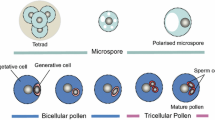Abstract
A series of studies, recently reviewed, has established that approximately 60% of the structural genes which are expressed in the sporophytic portion of the angiosperm life cycle are also expressed and exposed to selection in the pollen. Given the haploidy and large population sizes of pollen grains, a substantial portion of the sporophytic genome could thus be periodically exposed to a bacterial type of mass screening. This extraordinary possibility is often subject to some skepticism which may, of course, be justified. However, recent attempts to apply models appear to be inappropriate in this context, in part because these attempts overlook an important source of genetic variation, and also because they assume fixed values for selection and fitness. More recently, studies of pollen/pollen interactions have suggested that what Linskens termed the “programic phase” may represent an arena for important, and largely unexplored phenomena, some of which are discussed here.
Similar content being viewed by others
References
Brink RA, MacGillivray JH (1924) Segregation for the waxy locus in maize pollen and differential development of the male gametophyte. Am J Bot 11:465–469
Carney S, Cruzan M, Arnold M (1994) Reproductive interactions between hybridizing irises: analyses of pollen tube growth and fertilizing ability. Am J Bot 81:1169–1175
Charlesworth B (1987) The heritability of fitness. In: Bradbury WJ, Anderson MB (eds) Sexual selection: testing the alternatives. Wiley, New York, pp 21–40
Charlesworth D, Charlesworth B (1992) The effects of selection in the gametophyte stage on mutational load. Evolution 46:703–720
Charlesworth D, Morgan M, Charlesworth B (1990) Inbreeding depression, genetic load, and the evolution of outcrossing rates in a multilocus system with no linkage. Evolution 44:1469–1479
Cook S, Lefebune C, McNeilly T (1972) Competition between metal tolerant and normal plant populations on normal soil Evolution 26:366–372
Cruzan MB (1990) Pollen-pollen and pollen-style interactions during pollen tube growth inErythronium grandiflorum (Liliaceae). Am J Bot 77:116–122
Devlin B, Ellstrand N (1990) The development and application of a refined method for estimating gene flow from angiosperm paternity analysis. Evolution 44:248–259
Haldane JBS (1924) A mathematical theory of natural and artificial selection Trans Cambridge Philos Soc 23:19–4
Harper JL (1977) Population biology of plants. Academic Press, London
Hartl D, Clark A (1989) Principles of population genetics, 2nd edn. Sinauer, Sunderland, Mass
Herben T, Krahulec F (1990) Competitive hierarchies, reversals of rank order and the de Wit approach: are they compatible? Oikos 58:254–256
Hormaza, JI, Herrero M (1994) Gametophytic competition and selection. In: Williams EG, Clarke AE, Knox RB (eds) Genetic control of self-incompatibility and reproductive development in flowering plants. Kluwer, Dordrecht, pp 372–400
Hormaza, JI, Herrero M (1996) Male gametophyte selection as a plant breeding tool. Sci Hortic (in press)
Johnson CM, Mulcahy DL, Galinat WC (1978) Male gametophyte in maize: influences of the gametophytic genotype. Theor Appl Genet 48:299–303
Jones DF (1928) Selective fertilization. University of Chicago Press, Chicago, III
Landi PA, Frascaroli E (1988) Polen-style interactions inZea mays L In: Cresti M, Gori P, Pacini E (eds) Sexual reproduction in higher plants. Springer, Berlin Heidelberg New York, pp 315–320
Linskens HF, Pfahler PF (1977) Genotypic effects on the amino acid relationships in maize (Zea mays L.) pollen and style. Theor Appl Genet 50:173–177
Marshall DL, Folsom M (1991) Mate choice in plants: an anatomical to population perspective. Annu Rev Ecol Syst 22:37–64
Marshall C, Ludlam D (1989) The pattern of abortion of developing seeds inLolium perenne. Ann Bot 63:19–27
Ottaviano E, Sari Gorla M, Mulcahy DL (1980) Pollen tube growth rate inZea mays: implications for genetic improvement of crops. Science 210:437–438
Parker MA (1992) Outbreeding depression in a selfing annual. Evolution 46:837–841
Pfahler PL (1967) Fertilization ability of maize pollen grains. II. Pollen genotype, female sporophyte and pollen storage interactions. Genetics 57:513–521
Reice SR (1994) Nonequilibrium determinants of biological community structure. Am Sci 82:424–435
Richardson T, Stephenson A (1992) Effects of parentage and size of the pollen load on progeny performance inCampanula americana. Evoution 46:1731
Sari-Gorla M, Ottaviano E, Fiani D (1975) Genetic variability of gametophytic growth rate in maize. Theor Appl Genet 46: 289–294
Schmitt J, Gamble SE (1990) The effect of distance from the parental site in offspring performance and inbreeding depression inImpatiens capensis: a test of the local adaptation hypothesis. Evolution 44:2022–2030
Scudo FM (1967) Selection on both haplo- and diplophase. Genetics 56:693–704
Searcy KB, Mulcahy DL (1985) Pollen tube competition and selection for metal tolerance inSilene dioica (Carophyllaceae) andMimulus guttatus (Scrophulariaceae). Am J Bot 72:1695–1699
Sinervo B, Lively CM (1996) The rock-paper-scissors game and the evolution of alternative male strategies. Nature 380:240–243
Snow A (1986) Pollination dynamics inEpilobium canum (Onagraceae): c consequences for gametophytic selection. Am J Bot 73:139–151
Snow A (1990) Effects of pollen load size and number of donors on sporophyte fitness in wild radish (Raphanus raphanistrum). Am Nat 136:742–758
Snow A, Spira T (1991) Pollen vigor and the potential for sexual selection in plants. Nature 352:796–797
Thomson JD (1989) Germination schedules of pollen grains: implications for pollen selection. Evolution 43:220–223
Walsh NE, Charlesworth D (1992) Evolutionary interpretations of differences in pollen tube growth rates. Q Rev Biol 67:19–37
Waser NM, Price MV (1989) Optimal outcrossing inIpomopsis aggregata: seed set and offspring fitness. Evolution 43:1097–1110
Author information
Authors and Affiliations
Corresponding author
Rights and permissions
About this article
Cite this article
Mulcahy, D.L., Sari-Gorla, M. & Mulcahy, G.B. Pollen selection — past, present and future. Sexual Plant Reprod 9, 353–356 (1996). https://doi.org/10.1007/BF02441955
Received:
Accepted:
Issue Date:
DOI: https://doi.org/10.1007/BF02441955




